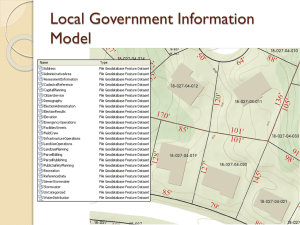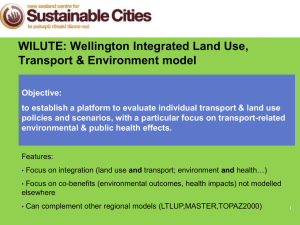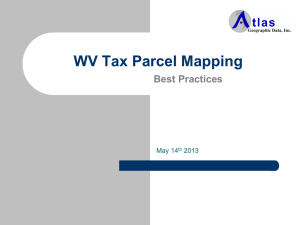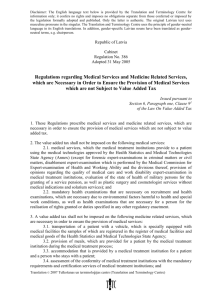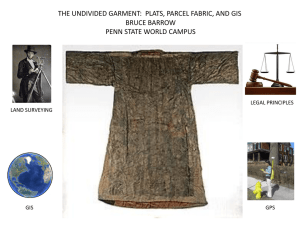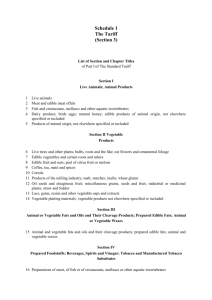Land_Survey_Law
advertisement
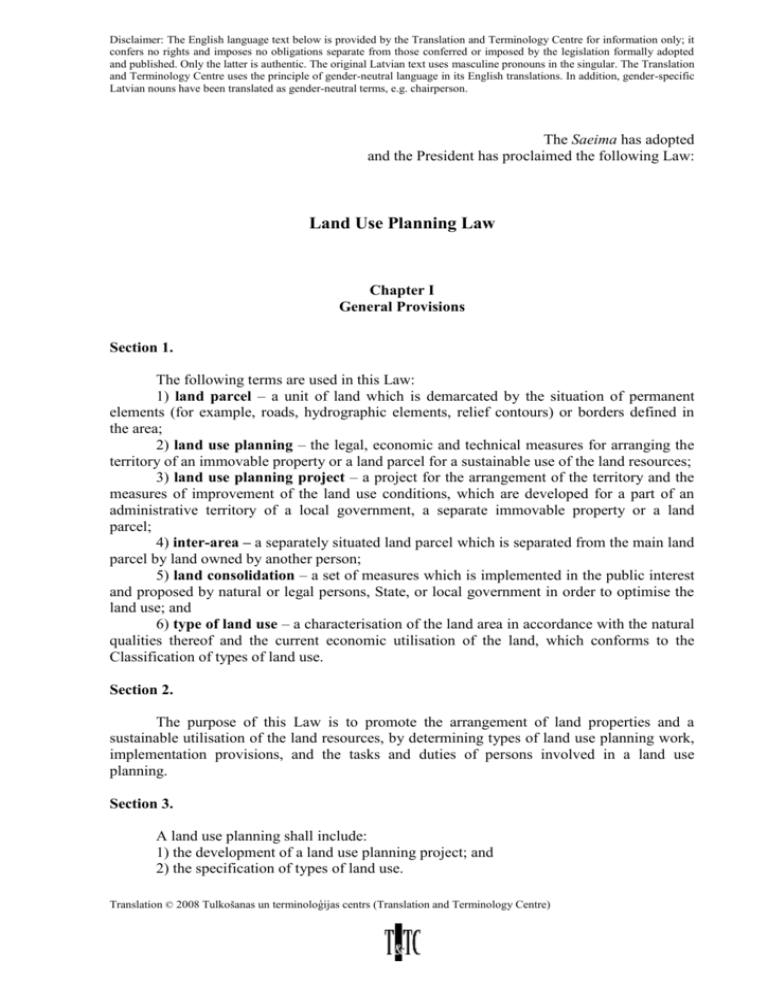
Disclaimer: The English language text below is provided by the Translation and Terminology Centre for information only; it confers no rights and imposes no obligations separate from those conferred or imposed by the legislation formally adopted and published. Only the latter is authentic. The original Latvian text uses masculine pronouns in the singular. The Translation and Terminology Centre uses the principle of gender-neutral language in its English translations. In addition, gender-specific Latvian nouns have been translated as gender-neutral terms, e.g. chairperson. The Saeima has adopted and the President has proclaimed the following Law: Land Use Planning Law Chapter I General Provisions Section 1. The following terms are used in this Law: 1) land parcel – a unit of land which is demarcated by the situation of permanent elements (for example, roads, hydrographic elements, relief contours) or borders defined in the area; 2) land use planning – the legal, economic and technical measures for arranging the territory of an immovable property or a land parcel for a sustainable use of the land resources; 3) land use planning project – a project for the arrangement of the territory and the measures of improvement of the land use conditions, which are developed for a part of an administrative territory of a local government, a separate immovable property or a land parcel; 4) inter-area – a separately situated land parcel which is separated from the main land parcel by land owned by another person; 5) land consolidation – a set of measures which is implemented in the public interest and proposed by natural or legal persons, State, or local government in order to optimise the land use; and 6) type of land use – a characterisation of the land area in accordance with the natural qualities thereof and the current economic utilisation of the land, which conforms to the Classification of types of land use. Section 2. The purpose of this Law is to promote the arrangement of land properties and a sustainable utilisation of the land resources, by determining types of land use planning work, implementation provisions, and the tasks and duties of persons involved in a land use planning. Section 3. A land use planning shall include: 1) the development of a land use planning project; and 2) the specification of types of land use. Translation © 2008 Tulkošanas un terminoloģijas centrs (Translation and Terminology Centre) Section 4. (1) Land use planning work shall be performed by certified persons, whose civil liability regarding the professional activity has been ensured. (2) A certificate shall be issued to the performer of land use planning work by a certification authority which is authorised by the Cabinet. (3) The certified person shall pay a State fee regarding the receipt of a certificate or extension of the term of validity thereof. (4) The procedures for the issuance and registration of a certificate, extension of the term of validity and cancellation thereof, supervision of the activities of certified persons, as well as the State fee rate and procedures for payment, the procedures for the civil liability insurance and the minimum amount for an insurance contract shall be determined by the Cabinet. Section 5. A land use planning project shall be initiated by: 1) a land owner or multiple owners, in relation to the properties thereof, or structure owners after co-ordination with the land owners, if the structures are superficiary and are independent property objects; 2) a State direct administration authority in relation to the land under the jurisdiction of the State if necessary in the State or public interest. The relevant land owner shall be informed regarding the proposal, if the land use planning project applies to the land at the disposal of the property thereof; 3) a local government in relation to the land under the jurisdiction thereof, if necessary for the performance of the autonomous functions thereof. The relevant land owner shall be informed regarding the proposal, if the land use planning project applies to the land at the disposal of the property thereof; 4) a State direct administration authority or a local government in relation to the immovable properties which are intended for expropriation for the purposes of the State or public; 5) a property owner, if the relevant object has a defined protection zone; or 6) administrations for the protected territories in relation to special areas of conservation. Section 6. Land use planning work or the evaluation and approval of the existing land use planning project shall be financed by the initiator thereof, except for the cases specified in the Protection Zone Law. If the land use planning work is initiated by several persons referred to in Section 5, Paragraph one of this Law, a co-financing share of each person shall be determined proportionally to the land area, owned by him or her, which is included in the land use planning project or by common accord. Translation © 2008 Tulkošanas un terminoloģijas centrs (Translation and Terminology Centre) 2 Chapter II Development of a Land Use Planning Project Section 7. A land use planning project shall be developed by complying with the spatial plan of the local government. Section 8. The land use planning project shall be developed for the following land use planning work: 1) the reorganisation of land parcel borders; 2) the exchange of land parcels or the elimination of inter-areas; 3) the division of land parcels (also those included in a joint property); 4) land consolidation; 5) the provision of access possibilities to the land parcel; 6) the provision of access to land areas (territories) of public use; and 7) the concretisation of such encumbrance of the immovable property which is specified in the spatial plan and other regulatory enactments referable to the land parcel. Section 9. (1) The land use planning project for the land use planning work referred to in Section 8 of this Law shall be developed for such territories, to which the regulatory enactments in the field of construction, environmental protection, regional and spatial planning policy or the decisions of the city council (board) of the local government do not prescribe the development of a detailed plan. (2) For the territory for which there is a valid detailed plan or, in accordance with the spatial plan of the local government, the development of a detailed plan is intended, but also the land use planning works referred to in Section 8 of this Law shall be performed, the land use planning project may be developed as a supplement to the detailed plan, in compliance with the conditions of the law, which are related to the development of the land use planning project. Section 10. (1) A land use planning project shall consist of an explanatory memorandum and a graphic part. The procedures for the development of the land use planning plan, content thereof, requirements related to the explanatory memorandum and graphic part shall be determined by the Cabinet. (2) The graphic part of the land use planning project shall be formed in the Latvian Geodesic Coordinate System LKS-92 within a level of detail necessary for the project. Section 11. (1) Interested land owners shall participate in the development of the land use planning project by submitting proposals thereof. Translation © 2008 Tulkošanas un terminoloģijas centrs (Translation and Terminology Centre) 3 (2) If the land use planning project shall be developed for a property which is encumbered with credit liabilities, a written consent of the creditor is necessary for the development of the relevant project. Section 12. (1) A developer of the land use planning project has a duty to evaluate the proposals of the persons referred to in Section 11, Paragraph one of this Law and within a time period of two weeks to inform them regarding compliance or rejection of the proposals thereof by indicating the rejection grounds. The proposals and replies thereof shall be registered and compiled in conformity with documentation regulations and shall be appended to the land use planning project. (2) When developing a land use planning project, the developer thereof shall invite persons involved in the implementation of the project to the consultation regarding the submitted proposals and possibilities to carry them out. Section 13. A land use planning project shall not be developed for the land properties regarding which judicial proceedings have been initiated and a prohibition notation has been entered in a Land Register or for which inheritance has been revealed. Section 14. The development of a land use planning project, for the division of a land parcel present in a joint property into separate properties, shall be initiated by all joint holders thereof or any one of them, in order to separate the undivided share owned by him or her into a separate property. Section 15. (1) Joint holders may not request a division of a land parcel present in a joint property into actual shares, if the land parcels to be separated do not conform to the territory utilisation and building provisions specified by the local government, as well as to the other cases specified in the regulatory enactments. (2) If the structure present in a land and structure joint property is indivisible, the structure and the land parcel required for the maintenance thereof may be separated from the land and structure joint property, if it conforms to the territory utilisation and building provisions specified by the local government. The referred to land together with the structure shall remain within the joint property, but the remaining land may be divided into separate properties in compliance with the specifications of Paragraph one of this Section. (3) The owners of the apartments of an apartment house may not request the division of the land parcel which is present in a joint property and is required for the maintenance of the house. Section 16. When dividing an existent land parcel of a joint property, formation of an inter-area is not permissible. Translation © 2008 Tulkošanas un terminoloģijas centrs (Translation and Terminology Centre) 4 Section 17. When developing a land use planning project for the reorganisation of the land parcel borders and for the land parcel exchange, a requirement that the cadastral value of the land parcels to be exchanged shall be equal shall be observed, but if it is not possible, equalisation of the land value shall be provided by means of a complementary fee by an agreement between the owners. If the land owners cannot come to an agreement, the reorganisation of the land parcel borders and the exchange of the land parcels shall not be performed. Section 18. (1) Regarding the development of the land use planning project, the procedures for the financing thereof and the essential tasks of the land use planning work the interested land parcel owners shall conclude an agreement. (2) After the development of the land use planning project the owners of the land parcels shall certify with a signature thereof that they agree to the implementation of the project solutions, the land parcel exchange or compensation conditions, as well as shall co-ordinate the borders of the designed land parcels. Section 19. (1) Prior to the approval at the local government of the land use planning project developed by a certified person, the project developer shall submit such project to the relevant regional office of the State Land Service which shall provide an opinion regarding its conformity to the requirements specified by the Cabinet. (2) The local government shall approve the land use planning project by issuing an administrative act. Section 20. The initiator of the development of the land use planning project shall submit the project in triplicate for the approval of the local government. Within a time period of two weeks the local government shall submit one copy of the approved project and a digital graphic part of the project in vector data format within the Latvian Geodesic Coordinate System LKS-92 free of charge to the relevant regional office of the State Land Service, but the second copy shall be handed over to the initiator. The third copy shall be stored in the archive of the local government. Section 21. If the property which is included in the land use planning project has been encumbered with credit liabilities, the transfer of such credit liabilities to the property (properties) to be newly-formed and entry of the land parcel to be designed in a Land Register shall be coordinated with the creditor. Section 22. A land use planning project shall be implemented within a time period of four years. If the spatial plan is being changed in the referred to time period, the land use planning project shall be evaluated respectively. If changes relate to the land parcel which is included in the land use planning project, the interested party shall initiate the evaluation of the project in the Translation © 2008 Tulkošanas un terminoloģijas centrs (Translation and Terminology Centre) 5 local government. If the land use planning project is not implemented, the interested party shall initiate the development of a new land use planning project or the evaluation and approval of the existing land use planning project. The land use planning project shall be implemented, if the designed land parcels have undergone a land survey, have been registered in the State cadastre information system of immovable property and have been entered in the Land Register. Chapter III Types of Land Use Section 23. Types of land use shall be determined and updated by performing a land survey. The entering and recording of the types of land use in the State cadastre information system of immovable property shall be performed by the State Land Service in conformity with the administrative territorial division. Section 24. The procedures for the categorisation of types of land use and specification criteria thereof shall be determined by the Cabinet. Transitional Provisions 1. During the land reform for the land properties which shall be formed by the procedures of the land privatization and land reform the land use planning projects shall be developed and approved in accordance with the Law On Land Reform in the Rural Areas of the Republic of Latvia, the Law On Land Reform in the Cities of the Republic of Latvia, the Cabinet Regulation No. 264 of 29 August 1995, Regulations Regarding Land Reform in Cities, and the decision of the Presidium of the Supreme Council of the Republic of Latvia On By-law Regarding “Implementation of the First Round of Land Reform in the Rural Areas of the Republic of Latvia” Approval of 21 February 1991. 2. Until 1 December 2006 the Cabinet shall issue: 1) the regulations for certification of land use planning work in conformity with Section 4 of this Law; 2) the regulations for the development of a land use planning project in conformity with Section 10, Paragraph one and Section 19, Paragraph one of this Law; and 3) the procedures for the classification of types of land use and specification criteria in conformity with Section 24 of this Law. 3. Licences for the performance of land use planning work in accordance with the procedures specified in regulatory enactments shall be issued until 31 December 2007. The licences for the performance of the land use planning work which have been issued until 31 December 2007 shall be valid until the term periods indicated in the document, but not longer than 31 December 2010. Translation © 2008 Tulkošanas un terminoloģijas centrs (Translation and Terminology Centre) 6 4. A person, to whom the land use rights have been granted in accordance with the Law On Land Use and Land Use Planning, the Law On Land Reform in the Rural Areas of the Republic of Latvia, the Law On Land Reform in the Cities of the Republic of Latvia, the Law On Completion of Land Reform in Rural Areas, the Law on Completion of Land Reform in Cities and the Law On the State and Local Government Land Ownership Rights and Recording of Such Rights in Land Registers, shall submit a land border plan to the Land Registry Office for recording of the land ownership rights and shall not develop the land use planning project. 5. The land under the jurisdiction of the State and local government shall be entered in the Land Register in conformity with the Law On the State and Local Government Land Ownership Rights and Recording of Such Rights in Land Registers, a land border plan shall be submitted to the Land Registry Office for recording of the land ownership rights and the land use planning project shall not be developed. 6. In relation to the territory for which a spatial plan of the local government is not developed, but in which the land use planning work referred to in Section 8 of this Law shall be performed, the decision regarding the development of the land use planning project shall be taken by the local government. This Law shall come into force on 1 January 2007. This Law has been adopted by the Saeima on 14 September 2006. Acting for the President, Chairperson of the Saeima I. Ūdre Rīga, 3 October 2006 Translation © 2008 Tulkošanas un terminoloģijas centrs (Translation and Terminology Centre) 7
